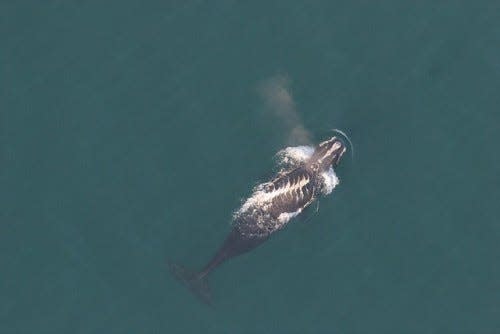The Right Whale: Do politics trump extinction for NJ delegation? | Opinion
- Oops!Something went wrong.Please try again later.
As whales die in the U.S. Atlantic, and as pro-and anti-wind debate sucks up the oxygen, the North Atlantic right whale faces an extinction crisis in real time.
The crisis is low-key. This is not the drama-packed, iconic “Save the Whales” campaign of the 1970s. There are no stand-offs at sea, no banners flying over the Capitol. There should be.
Right whales, so named because they were the “right” whales to pursue and kill, never fully recovered; there are 340, or fewer, alive today, down from 481 in 2011. With only 70 breeding females left, the right whale will be functionally extinct by 2035.
It gets worse. The U.S. Congress has delayed until 2028 emergency regulations to stem right whale fatalities in lobster traps, pots and lines, deliberately withholding emergency measures for five years from a whale that will be functionally extinct in 12.

Lo these millions of years, it turns out that the gravely endangered whales do not belong to themselves, to the sea or maybe to God, but to the state of Maine — specifically, the lobster industry and its politicians. Congress seems to have ceded the point.
The most pressing threats to right whales, and to large whales globally, are entanglement in fishing gear and collisions with vessels.
Whales are ensnared by vertical-lines or ropes — trap/pot gear, used for catching lobsters and Jonah crabs, and gillnets for catching fish — that extend from the water’s surface to the ocean floor.
Due to their coastal presence and frequent nearness to the water’s surface, right whales, mothers and calves especially, are particularly vulnerable to vessel strikes and blunt force injury.
On the Atlantic coast, reports Oceana, vessel non-compliance with speed restrictions can be as high as 90% in mandatory speed zones, and up to 85% in voluntary ones. Slowing speeds to 10 knots reduces a right whale’s risk of death from vessel strikes by 80 to 90%.
National Ocean and Atmospheric Administration has proposed, but keeps delaying, regulations to expand 10 knot speed limit requirements to vessels 35-feet and above and establishes mandatory closures of high-risk areas.
More perspective: This is how NJ legislators can save the Shore
The Maine delegation opposes the rule. Boating trade associations are fighting the 10-knot regulation as an inconvenience.
In 2021, NOAA finalized a rule to lessen lethal entanglement in lobster fishing gear. A federal court found that NOAA had failed to protect the right whale under the Endangered Species Act and ordered the agency to produce a stricter rule by 2024.
In December 2022, the Maine delegation led by Sen. Susan Collins, a Republican, slipped a rider onto the 2023 omnibus budget bill that effectively nullified the federal court ruling and delayed the NOAA deadline and protective rule until 2028, when they will try to block it again.
An ocean advocacy group filed a petition for emergency rulemaking to lower speed limits to protect mother-calf pairs from boat strikes. The Biden administration rejected the request.
When Monterey Bay Aquarium’s Seafood Watch “red listed” American lobster fishing gear as a threat to the right whale and advised seafood consumers to avoid lobster, the lobster industry sued the aquarium for “defamation.”Next, Susan Collins blocked a NOAA nominee’s appointment over the agency’s rule to protect the rare whale.
Before elections, Maine Rep. Jared Golden, a Democrat, introduced and campaigned on a bill to strip funding from Monterey Bay Aquarium.
NOAA reports that continued use of present methods will allow entanglement to continue at levels at least five times higher than the right whale population could withstand.
House Natural Resources Committee Ranking Member Rep. Raul Grijalva, D-Arizona, has pushed back by introducing the RESCUE Whales Act, H.R. 1213, to repeal Maine’s protection prohibition. The bill has seven co-sponsors, from Colorado, the Mariana Islands, but not one from New Jersey — for an East Coast whale in a death spiral, with daily East Coast headlines. Why not?
Grijalva also worked to obtain $20 million to help the lobster industry transition to modern, ropeless gear. Now, the money is just sitting there.
Ancient whales are sharing the seas with ever-increasing commercial fisheries, tankers, noise, crowded shipping lanes, new sea-based industries, warming seas and shifting food sources. We humans must be willing to make the changes necessary for their continued existence.
What astonishes is the choice itself. Ditching the ESA, Collins and company presumed to weigh transitioning to ropeless gear against the absolute certainty that unless government acts, the right whale will vanish from the face of the earth, and blocked protection.
As a nation, we’ve already made that choice. In 1973, Congress enacted the ESA “to halt and reverse the trend toward species extinction, whatever the cost.”
Save the North Atlantic right whale. Now.
Susan Russell is wildlife policy director for Animal Protection League of New Jersey.
This article originally appeared on Asbury Park Press: North Atlantic Right Whale: Where is NJ congressional delegation?
